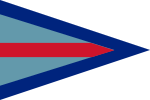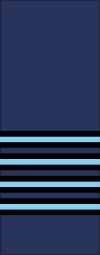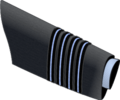Group captain
Group captain is a senior commissioned rank in many air forces. Group captain has a NATO rank code of OF-5, meaning that it ranks above wing commander, immediately below air commodore and is the equivalent of the naval rank of captain and the rank of colonel in other services.
| Group captain | |
|---|---|
 An RAF group captain's command flag | |
 A group captain's sleeve/shoulder insignia from the Royal Air Force | |
| Service branch | Air forces |
| Abbreviation | Gp Capt / GPCAPT |
| NATO rank | OF-5 |
| Non-NATO rank | O-6 |
| Formation | 1 April 1918 (RAF) |
| Next higher rank | Air commodore |
| Next lower rank | Wing commander |
| Equivalent ranks | |
While the rank originated in the British Royal Air Force (RAF),[1] group captain is a rank used by the air forces of many Commonwealth and other countries that have been influenced by British military culture. It is sometimes used as the English translation of an equivalent rank in countries which have a non-English air force-specific rank structure.
It is usually abbreviated Gp Capt. In some air forces (such as the RAF, IAF and PAF), GPCAPT is used while in others (such as the RAAF and RNZAF) and sometimes, especially in historical contexts, as G/C. The rank of group captain is not correctly abbreviated as "captain".
RAF usage
- History
On 1 April 1918, the newly created RAF adopted its officer rank titles from the British Army, with Royal Naval Air Service captains and Royal Flying Corps colonels becoming colonels in the RAF. In response to the proposal that the RAF should use its own rank titles, it was suggested that the RAF might use the Royal Navy's officer ranks, with the word "air" inserted before the naval rank title. For example, the rank that later became group captain would have been "air captain". Although the Admiralty objected to this simple modification of their rank titles, it was agreed that the RAF might base many of its officer rank titles on naval officer ranks with differing pre-modifying terms. It was also suggested that RAF colonels might be entitled "bannerets" or "leaders". However, the rank title based on the Navy rank was preferred and as RAF colonels typically commanded groups the rank title group captain was chosen. The rank of group captain has been used continuously since 1 August 1919.
Although in the early years of the RAF groups were normally commanded by group captains, by the mid-1920s they were usually commanded by an air officer.
In the post-World War II period the commander of an RAF flying station or a major ground training station has typically been a group captain. More recently, expeditionary air wings have also been commanded by group captains.
- Insignia and command pennant
The rank insignia is based on the four gold bands of captains in the Royal Navy, comprising four narrow light blue bands over slightly wider black bands. This is worn on both the lower sleeves of the tunic or on the shoulders of the flying suit or the casual uniform. Group captains are the first rank in the RAF hierarchy to wear gold braid on the peak of their cap, informally known as 'scrambled egg'; however, they still wear the standard RAF officer's cap badge.
The command pennant for a group captain is similar to the one for a wing commander except that there is one broad red band in the centre. Only the wing commander and group captain command pennants are triangular in shape.
 An RAF group captain's sleeve/shoulder insignia
An RAF group captain's sleeve/shoulder insignia An RAF group captain's sleeve mess insignia
An RAF group captain's sleeve mess insignia An RAF group captain's sleeve as it appears on the No. 1 dress
An RAF group captain's sleeve as it appears on the No. 1 dress
Other air forces
The rank of group captain is also used in a number of the air forces in the Commonwealth, including the Bangladesh Air Force, Ghana Air Force, Indian Air Force (IAF), Namibian Air Force, Nigerian Air Force, Pakistan Air Force (PAF), Royal Australian Air Force (RAAF), Royal New Zealand Air Force (RNZAF), Sri Lankan Air Force and the Trinidad and Tobago Air Guard.[2] It is also used in the Egyptian Air Force, Hellenic Air Force, Royal Air Force of Oman and the Royal Thai Air Force.
The Royal Canadian Air Force used the rank until the unification of the Canadian Forces in 1968, when army-type rank titles were adopted. A Canadian group captain then became a colonel. In official French Canadian usage, a group captain's rank title was colonel d'aviation. In the Argentine Air Force comodoro (commodore) is the rank in Argentine Spanish while in the Chilean Air Force, the rank in Chilean Spanish is coronel de aviacion or "colonel of aviation". Until 1973 it was used by the Royal Malaysian Air Force (RMAF), today the sleeve insignia is that of a full colonel.
 An RAAF group captain's sleeve/shoulder insignia
An RAAF group captain's sleeve/shoulder insignia A RNZAF group captain's sleeve/shoulder insignia
A RNZAF group captain's sleeve/shoulder insignia A HAF sminarchos (group captain's) rank insignia
A HAF sminarchos (group captain's) rank insignia A PAF group-captain's rank insignia.
A PAF group-captain's rank insignia. An IAF group captain's rank insignia
An IAF group captain's rank insignia A Namibian Air Force group captain's rank insignia
A Namibian Air Force group captain's rank insignia.svg.png) A RTAF group captain's rank insignia
A RTAF group captain's rank insignia
Equivalent ranks in other services
In addition to the equivalents used in most air forces, such as colonel, other air services, especially non-combat auxiliaries in Commonwealth countries, have used a variety of alternative names for equivalent ranks.
The equivalent rank in the Women's Auxiliary Air Force, Women's Auxiliary Australian Air Force, Women's Royal Air Force (until 1968) and Princess Mary's Royal Air Force Nursing Service (until 1980) was "group officer".
The equivalent rank in the Royal Observer Corps (until 1995) was "observer captain", which had a similar rank insignia.
Notable group captains
- Sir Douglas Bader CBE, DSO & Bar, DFC & Bar, DL, FRAeS – World War II fighter pilot and double amputee
- Clive Robertson "Killer" Caldwell DSO, DFC & Bar, Cross of Valor (Poland) – Australia's highest-scoring fighter ace and the highest-scoring P-40 pilot from any air force and the highest-scoring Allied pilot in North Africa. Became one of a small group of pilots throughout history to become an "Ace in a day"
- Leonard Cheshire VC – World War II bomber pilot and charity worker
- Walter Churchill DSO, DFC – World War II ace fighter pilot, who also evaluated various makes of fighter aircraft for the RAF, and played a key role in getting Spitfire aircraft to the defence of Malta
- Bruce Dickinson – Frontman of Iron Maiden. Honorary Gp. Capt. of 601 (County of London) Squadron RAF[3]
- Hugh Dundas – World War II fighter pilot and the youngest person to hold this rank, aged 24 years
- Thomas Loel Guinness – World War II fighter pilot, politician and businessman
- Sir Chris Hoy MBE – Honorary Gp. Capt. as former Ambassador to the Royal Air Force Air Cadets
- Hamish Mahaddie DSO, DFC, AFC & Bar, FRAeS – Scotsman who flew in Bomber Command and became a key member of the Pathfinder Force as chief procurer of aircrew talent, often referred to as Don Bennett's "horse thief"
- Herbert Massey – as a POW was Senior British Officer (SBO) at Stalag Luft III. He was portrayed in the movie The Great Escape (1963) as Group Captain Ramsey, and played by James Donald. Massey was crippled and walked with a stick, as did his character in the movie
- Percy Charles Pickard DSO & Two Bars, DFC – World War II bomber pilot and captain of "F for Freddie" in Target for Tonight, killed in Operation Jericho
- Stanisław Skarżyński – World War II bomber pilot. Commanding Officer RAF Lindholme. Polish Air Force. Transatlantic World Record Holder. Awarded Blériot Medal 1936
- James Stagg – RAF meteorologist involved in the planning of the D-Day invasion
- Clare Stevenson Director WAAAF
- Sachin Tendulkar – Honorary Indian Air Force group captain for his achievements in cricket
- Peter Townsend – World War II pilot and suitor of Princess Margaret
- Carol Vorderman MBE – Honorary Gp. Capt. as current Ambassador to the Royal Air Force Air Cadets
Fictional characters
- Ian Gilmore, a fictional character in Doctor Who
- Group Captain Tennant James, a fictional character in Doctor Who
- Captain Jack Harkness, fictional character in Doctor Who and its spin-off Torchwood
- Group Capt. Lionel Mandrake, in the film Dr. Strangelove, played by Peter Sellers
See also
- Air force officer rank insignia
- British and U.S. military ranks compared
- Comparative military ranks
- RAF officer ranks
- Ranks of the RAAF
References
- "Ranks and Badges of the Royal Air Force". Royal Air Force. 2007. Archived from the original on 6 June 2011. Retrieved 1 December 2007.
- http://www.news.gov.tt/archive//E-Gazette/Gazette%202014/Gazette/Gazette%20No.%20140%20of%202014.pdf
- "Iron Maiden Lead Singer Bruce Dickinson Made Honorary Group Captain In RAF".